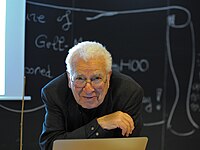奇夸克
| 组成 | 基本粒子 |
|---|---|
| 系 | 费米子 |
| 代 | 第二代 |
| 基本相互作用 | 强相互作用 弱相互作用 电磁相互作用 引力相互作用 |
| 符号 | s |
| 反粒子 | 反奇夸克( s ) |
| 理论 | 默里·盖尔曼(1964年) 乔治·茨威格(1964年) |
| 发现 | 1968, SLAC |
| 质量 | 95+5 −5 MeV/c2[1] |
| 衰变粒子 | 上夸克 |
| 电荷 | −1/3 e |
| 色荷 | 是 |
| 自旋 | 1⁄2 |
| 弱同位旋 | LH: −1/2, RH: 0 |
| 弱超荷 | LH: 1/3, RH: −2/3 |
奇夸克(Strange quark)是基本粒子的一种,裸质量为95+5
−5 MeV/c2,是第三轻的夸克,只有上夸克与下夸克比其还轻。在很多种强子里,都可以找到奇夸克,例如,K介子(
K
)、D介子(
D
s)、Σ粒子(
Σ
)等等奇异粒子。[1]
奇夸克是第二代粒子,带有电荷−1/3 e。如同所有夸克,奇夸克属于费米子,自旋为1/2。奇夸克会感受到所有四种基本相互作用:引力相互作用、电磁相互作用、弱相互作用、强相互作用。奇夸克的反粒子是反奇夸克,奇夸克带有负电荷,反奇夸克带有正电荷。[1]
1947年,曼彻斯特大学的物理学者乔治·罗彻斯特与克里福德·巴特勒从宇宙线在云室里的踪迹照片找到K介子,其为最早被发现的奇异粒子。[2]1964年,默里·盖尔曼和乔治·茨威格为了建立夸克模型而假设奇粒子的存在。最初证实这假设的是物理学者在斯坦福直线加速器中心于1968年所做的深度非弹性碰撞实验。这实验确定上夸克与下夸克的存在,从而延伸至奇夸克的存在,因为它们可以确保八重道的成立。
历史[编辑]


在粒子物理学初期(二十世纪前半期),质子、中子、π介子等等强子类粒子都被认为是基本粒子。然而随著更多强子被发现,粒子园从1930年代早期与1940年代的几个粒子增加到1950年代的几十个粒子。然而,有些粒子的平均寿命比其它粒子长久很多,通过强相互作用衰变的粒子的平均寿命大约为10−23秒,而通过弱相互作用衰变的粒子却可以有约10−10秒。在研究这些衰变时,默里·盖尔曼(1953年)[3][4]与西岛和彦(1955年)[5]发展出奇异性的概念来解释为什么长寿命粒子的平均寿命比其它粒子长久很多。他们对于奇异衰变的研究导致盖尔曼-西岛关系的发现。
物理学者起初并不清楚它们彼此之间的关系。1961年,默里·盖尔曼[6]与尤瓦尔·内埃曼[7]各自独立地提出一种强子分类方案,称为“八重道”,利用SU(3)味对称性将强子组织为同位旋多重态。1964年,盖尔曼[8]与乔治·茨威格[9][10]各自独立地提出夸克模型,才将同位旋与奇异性背后的物理根据解释清楚。在那时,夸克模型只涉及到上夸克、下夸克与奇夸克[11]。上夸克与下夸克是同位旋的载子,而奇夸克则是奇异性的载子。虽然夸克模型解释了八重道,并没有任何实验证实夸克的存在,直到 1968年才在斯坦福直线加速器中心 找到夸克的踪迹[12][13]。深度非弹性碰撞实验揭示,质子具有次结构,质子是由三个更基础的粒子组成,因此证实了夸克模型[14]。
刚开始,人们并不情愿辨识这三个基础粒子为夸克,而是青睐理查·费曼的部分子模型[15][16][17]。随著时间演进,夸克模型渐渐被广泛接受(更多细节,请参阅条目J/ψ介子,人称“十一月革命”)[18]。
参阅[编辑]
参考文献[编辑]
- ^ 1.0 1.1 1.2 J. Beringer (Particle Data Group); et al. PDGLive Particle Summary 'Quarks (u, d, s, c, b, t, b′, t′, Free)' (PDF). Particle Data Group. 2012 [2012-11-30]. (原始内容 (PDF)存档于2013-05-12).
- ^ Clifford Butler and George Rochester discover the kaon, first strange particle. CERN timelines. CERN. [2018-07-17]. (原始内容存档于2018-07-18).
- ^ M. Gell-Mann. Isotopic Spin and New Unstable Particles. Physical Review. 1953, 92 (3): 833. Bibcode:1953PhRv...92..833G. doi:10.1103/PhysRev.92.833.
- ^ G. Johnson. Strange Beauty: Murray Gell-Mann and the Revolution in Twentieth-Century Physics. Random House. 2000: 119 [2018-07-17]. ISBN 0-679-43764-9. (原始内容存档于2019-05-02).
By the end of the summer ... [Gell-Mann] completed his first paper, "Isotopic Spin and Curious Particles" and send it of to Physical Review. The editors hated the title, so he amended it to "Strange Particles". They wouldn't go for that either—never mind that almost everybody used the term—suggesting insteand "Isotopic Spin and New Unstable Particles".
- ^ K. Nishijima, Kazuhiko. Charge Independence Theory of V Particles. Progress of Theoretical Physics. 1955, 13 (3): 285. Bibcode:1955PThPh..13..285N. doi:10.1143/PTP.13.285.
- ^
M. Gell-Mann. The Eightfold Way: A theory of strong interaction symmetry. M. Gell-Mann, Y. Ne'eman (编). The Eightfold Way. Westview Press. 2000: 11 [1964]. ISBN 0-7382-0299-1.
Original: M. Gell-Mann. The Eightfold Way: A theory of strong interaction symmetry. Synchrotron Laboratory Report CTSL-20 (California Institute of Technology). 1961. - ^
Y. Ne'eman. Derivation of strong interactions from gauge invariance. M. Gell-Mann, Y. Ne'eman (编). The Eightfold Way. Westview Press. 2000 [1964]. ISBN 0-7382-0299-1.
Original Y. Ne'eman. Derivation of strong interactions from gauge invariance. Nuclear Physics. 1961, 26 (2): 222. Bibcode:1961NucPh..26..222N. doi:10.1016/0029-5582(61)90134-1. - ^ M. Gell-Mann. A Schematic Model of Baryons and Mesons. Physics Letters. 1964, 8 (3): 214–215. Bibcode:1964PhL.....8..214G. doi:10.1016/S0031-9163(64)92001-3.
- ^ G. Zweig. An SU(3) Model for Strong Interaction Symmetry and its Breaking. CERN Report No.8181/Th 8419. 1964.
- ^ G. Zweig. An SU(3) Model for Strong Interaction Symmetry and its Breaking: II. CERN Report No.8419/Th 8412. 1964.
- ^ B. Carithers, P. Grannis. Discovery of the Top Quark (PDF). Beam Line (SLAC). 1995, 25 (3): 4–16 [2008-09-23]. (原始内容存档 (PDF)于2016-12-03).
- ^ E. D. Bloom; Coward, D.; Destaebler, H.; Drees, J.; Miller, G.; Mo, L.; Taylor, R.; Breidenbach, M.; et al. High-Energy Inelastic e–p Scattering at 6° and 10°. Physical Review Letters. 1969, 23 (16): 930–934. Bibcode:1969PhRvL..23..930B. doi:10.1103/PhysRevLett.23.930.
- ^ M. Breidenbach; Friedman, J.; Kendall, H.; Bloom, E.; Coward, D.; Destaebler, H.; Drees, J.; Mo, L.; Taylor, R.; et al. Observed Behavior of Highly Inelastic Electron–Proton Scattering. Physical Review Letters. 1969, 23 (16): 935–939. Bibcode:1969PhRvL..23..935B. doi:10.1103/PhysRevLett.23.935.
- ^ J. I. Friedman. The Road to the Nobel Prize. Hue University. [2008-09-29]. (原始内容存档于2008-12-25).
- ^ R. P. Feynman. Very High-Energy Collisions of Hadrons. Physical Review Letters. 1969, 23 (24): 1415–1417. Bibcode:1969PhRvL..23.1415F. doi:10.1103/PhysRevLett.23.1415.
- ^
S. Kretzer; Lai, H.; Olness, Fredrick; Tung, W.; et al. CTEQ6 Parton Distributions with Heavy Quark Mass Effects. Physical Review D. 2004, 69 (11): 114005. Bibcode:2004PhRvD..69k4005K. arXiv:hep-ph/0307022
 . doi:10.1103/PhysRevD.69.114005.
. doi:10.1103/PhysRevD.69.114005.
- ^ D. J. Griffiths. Introduction to Elementary Particles. John Wiley & Sons. 1987: 42. ISBN 0-471-60386-4.
- ^ M. E. Peskin, D. V. Schroeder. An introduction to quantum field theory. Addison–Wesley. 1995: 556. ISBN 0-201-50397-2.
进阶阅读[编辑]
- R. Nave. Quarks. HyperPhysics. Georgia State University, Department of Physics and Astronomy. [2008-06-29]. (原始内容存档于2015-09-05).
- A. Pickering. Constructing Quarks. University of Chicago Press. 1984: 114–125. ISBN 0-226-66799-5.
| |||||||||||||||||||||||||||||||||||||||||||||||||||||||||||||||||||||||||||||||||||||
